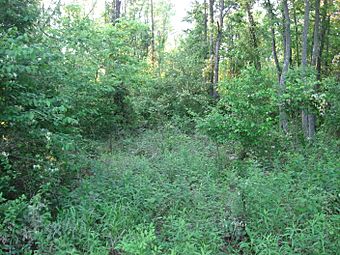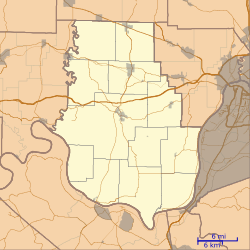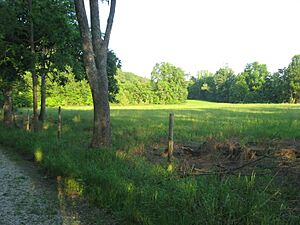Swan's Landing Archeological Site facts for kids
Quick facts for kids |
|
|
Swan's Landing Archeological Site (12HR304)
|
|

Woods at the site
|
|
| Location | Mile 658 on the Ohio River |
|---|---|
| Nearest city | New Amsterdam, Indiana |
| Area | 1.4 acres (0.57 ha) |
| NRHP reference No. | 87000517 |
| Added to NRHP | April 2, 1987 |
The Swan's Landing Archeological Site is an ancient place in Harrison County, Indiana, United States. It's where archaeologists found tools and clues from the Early Archaic period. This period was a very long time ago in North America.
Even though people have damaged the site over the years, it's still one of the most important places to learn about this time. Because of its historical value, it has been named a special historic site.
Contents
Where is Swan's Landing Located?
This important site is found along the Ohio River. Much of it is buried under as much as 6 metres (20 ft) (about 20 feet) of river mud and sand. It sits at Mile 658 on the river, which is about 3.5 kilometres (2.2 mi) (2 miles) north of New Amsterdam. It's also about 6 kilometres (3.7 mi) (3.7 miles) upstream from where the Blue River joins the Ohio.
The site covers about 5 hectares (12 acres) (12 acres). It got its name because the Swan family used to have a landing here for riverboats. Close by, you can find a dirt road, a large pond, and the mouth of Indian Creek about 1,800 metres (5,900 ft) (about a mile) to the south.
How the Site Was Damaged
People in the area first learned about the site in the early 1960s. At that time, collectors were finding old projectile points (like arrowheads) on the river beach. However, the site was not officially written about until 1982.
Between these years, the site was badly damaged by human actions. Some people knew there were many artifacts buried there. They started digging with shovels into the riverbanks. Others even used high-pressure hoses to wash away the top layers of soil. By the early 1980s, when professional archaeologists found the site, a lot of soil and artifacts had already been removed.
Also, changes to the Cannelton Locks and Dam downstream in 1974 caused the river level to rise. This led to fast erosion of the riverbank. By the mid-1990s, the riverbank had worn away by more than 20 metres (66 ft) (about 65 feet) from where it used to be.
What Archaeologists Found
In the summer of 1986, archaeologists studied the site. They wanted to see if it was important enough to be listed on the National Register of Historic Places. The Glenn Black Laboratory of Archaeology at Indiana University led this work. The Indiana Department of Natural Resources helped pay for it.
Professional studies in the 1980s showed a long line of ancient remains stretching for at least 500 metres (1,600 ft) (about a third of a mile) along the riverbank. They found many types of tools from the Early Archaic period. These included Kirk cluster projectile points, different kinds of scrapers, hammerstones, large celts, and bifaces (tools shaped on both sides). Many other kinds of stone tools were also found.
Most of these tools were made from Wyandotte chert. This is a very good quality stone found mostly in Harrison County and nearby areas. Archaeologists also found a lot of charcoal and several hearths (old fireplaces). The tools found here were not damaged by heat. This suggests that the people living there knew how to build wood fires that had good aeration (air flow). Their fires were not just wood; they also used coal, oil shale, and maybe even manganese dioxide as fuel.
Scientists used radiocarbon dating on some artifacts. This method tells how old something is. However, the dates they got varied a lot, sometimes by as much as 8,000 years. Many dates were either too old or too new for the Early Archaic period. This means the dating results were not perfect in some way.
What Swan's Landing Tells Us
The huge number of stone tools found at Swan's Landing shows that the site was like a factory. People came here to make stone tools from nearby stone sources. Some tools were finished at the site. Many blanks (partially shaped stones) were also made here to be finished somewhere else.
Almost all the stone tools found at the site are made of local Wyandotte chert. This suggests that the people who used the site did not travel far or trade stone with other groups. Swan's Landing seems to have been used by very skilled workers. The wide variety of tools suggests that these workers were highly specialized, meaning they had specific skills.
It's possible that different tribes used the site. One expert thinks it might have been a trading post where different groups met. There isn't much evidence of daily life at the site. This suggests that groups probably camped there for only short periods. The reason people stopped using the site might be that they found other places nearby that were better for making tools.
Why the Site is Important Today
In 1987, Swan's Landing was added to the National Register of Historic Places. This was because of its great archaeological importance. Other sites from the Early Archaic period where tools were made are known in other parts of the country. Examples include the Houserville and Tudek Sites in Pennsylvania. The artifacts found at Swan's Landing are similar to those from the St. Albans Site in West Virginia and Icehouse Bottom in Tennessee.
Even with all the damage it has faced, the amount of information still at Swan's Landing makes it one of the most important Early Archaic sites in eastern North America.
Images for kids







